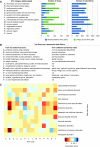A side effect resource to capture phenotypic effects of drugs
- PMID: 20087340
- PMCID: PMC2824526
- DOI: 10.1038/msb.2009.98
A side effect resource to capture phenotypic effects of drugs
Abstract
The molecular understanding of phenotypes caused by drugs in humans is essential for elucidating mechanisms of action and for developing personalized medicines. Side effects of drugs (also known as adverse drug reactions) are an important source of human phenotypic information, but so far research on this topic has been hampered by insufficient accessibility of data. Consequently, we have developed a public, computer-readable side effect resource (SIDER) that connects 888 drugs to 1450 side effect terms. It contains information on frequency in patients for one-third of the drug-side effect pairs. For 199 drugs, the side effect frequency of placebo administration could also be extracted. We illustrate the potential of SIDER with a number of analyses. The resource is freely available for academic research at http://sideeffects.embl.de.
Conflict of interest statement
In addition to his employment at the European Molecular Biology Laboratory (EMBL), IL is also the Chief Executive Officer of biobyte solutions GmbH, which handles commercial licensing of SIDER for EMBL.
Figures



Similar articles
-
The SIDER database of drugs and side effects.Nucleic Acids Res. 2016 Jan 4;44(D1):D1075-9. doi: 10.1093/nar/gkv1075. Epub 2015 Oct 19. Nucleic Acids Res. 2016. PMID: 26481350 Free PMC article.
-
Building the process-drug-side effect network to discover the relationship between biological processes and side effects.BMC Bioinformatics. 2011 Mar 29;12 Suppl 2(Suppl 2):S2. doi: 10.1186/1471-2105-12-S2-S2. BMC Bioinformatics. 2011. PMID: 21489221 Free PMC article.
-
Exploring the associations between drug side-effects and therapeutic indications.J Biomed Inform. 2014 Oct;51:15-23. doi: 10.1016/j.jbi.2014.03.014. Epub 2014 Apr 13. J Biomed Inform. 2014. PMID: 24727480
-
[Adverse Effect Predictions Based on Computational Toxicology Techniques and Large-scale Databases].Yakugaku Zasshi. 2018;138(2):185-190. doi: 10.1248/yakushi.17-00174-4. Yakugaku Zasshi. 2018. PMID: 29386432 Review. Japanese.
-
Evaluation of patient reporting of adverse drug reactions to the UK 'Yellow Card Scheme': literature review, descriptive and qualitative analyses, and questionnaire surveys.Health Technol Assess. 2011 May;15(20):1-234, iii-iv. doi: 10.3310/hta15200. Health Technol Assess. 2011. PMID: 21545758 Review.
Cited by
-
GADTI: Graph Autoencoder Approach for DTI Prediction From Heterogeneous Network.Front Genet. 2021 Apr 9;12:650821. doi: 10.3389/fgene.2021.650821. eCollection 2021. Front Genet. 2021. PMID: 33912218 Free PMC article.
-
Mining severe drug-drug interaction adverse events using Semantic Web technologies: a case study.BioData Min. 2015 Mar 25;8:12. doi: 10.1186/s13040-015-0044-6. eCollection 2015. BioData Min. 2015. PMID: 25829948 Free PMC article.
-
Mapping scientific landscapes in UMLS research: a scientometric review.J Am Med Inform Assoc. 2020 Oct 1;27(10):1612-1624. doi: 10.1093/jamia/ocaa107. J Am Med Inform Assoc. 2020. PMID: 33059367 Free PMC article. Review.
-
A survey on the computational approaches to identify drug targets in the postgenomic era.Biomed Res Int. 2015;2015:239654. doi: 10.1155/2015/239654. Epub 2015 Apr 28. Biomed Res Int. 2015. PMID: 26060814 Free PMC article. Review.
-
Towards FAIR protocols and workflows: the OpenPREDICT use case.PeerJ Comput Sci. 2020 Sep 21;6:e281. doi: 10.7717/peerj-cs.281. eCollection 2020. PeerJ Comput Sci. 2020. PMID: 33816932 Free PMC article.
References
-
- Ashburn TT, Thor KB (2004) Drug repositioning: identifying and developing new uses for existing drugs. Nat Rev Drug Discov 3: 673–683 - PubMed
-
- Barsky AJ, Saintfort R, Rogers MP, Borus JF (2002) Nonspecific medication side effects and the nocebo phenomenon. JAMA 287: 622–627 - PubMed
-
- Bender A, Scheiber J, Glick M, Davies JW, Azzaoui K, Hamon J, Urban L, Whitebread S, Jenkins JL (2007) Analysis of pharmacology data and the prediction of adverse drug reactions and off-target effects from chemical structure. Chem Med Chem 2: 861–873 - PubMed
-
- Campillos M, Kuhn M, Gavin AC, Jensen LJ, Bork P (2008) Drug target identification using side-effect similarity. Science 321: 263–266 - PubMed
-
- Fliri AF, Loging WT, Volkmann RA (2007) Analysis of system structure-function relationships. Chem Med Chem 2: 1774–1782 - PubMed
Publication types
MeSH terms
Substances
LinkOut - more resources
Full Text Sources
Other Literature Sources
Medical

